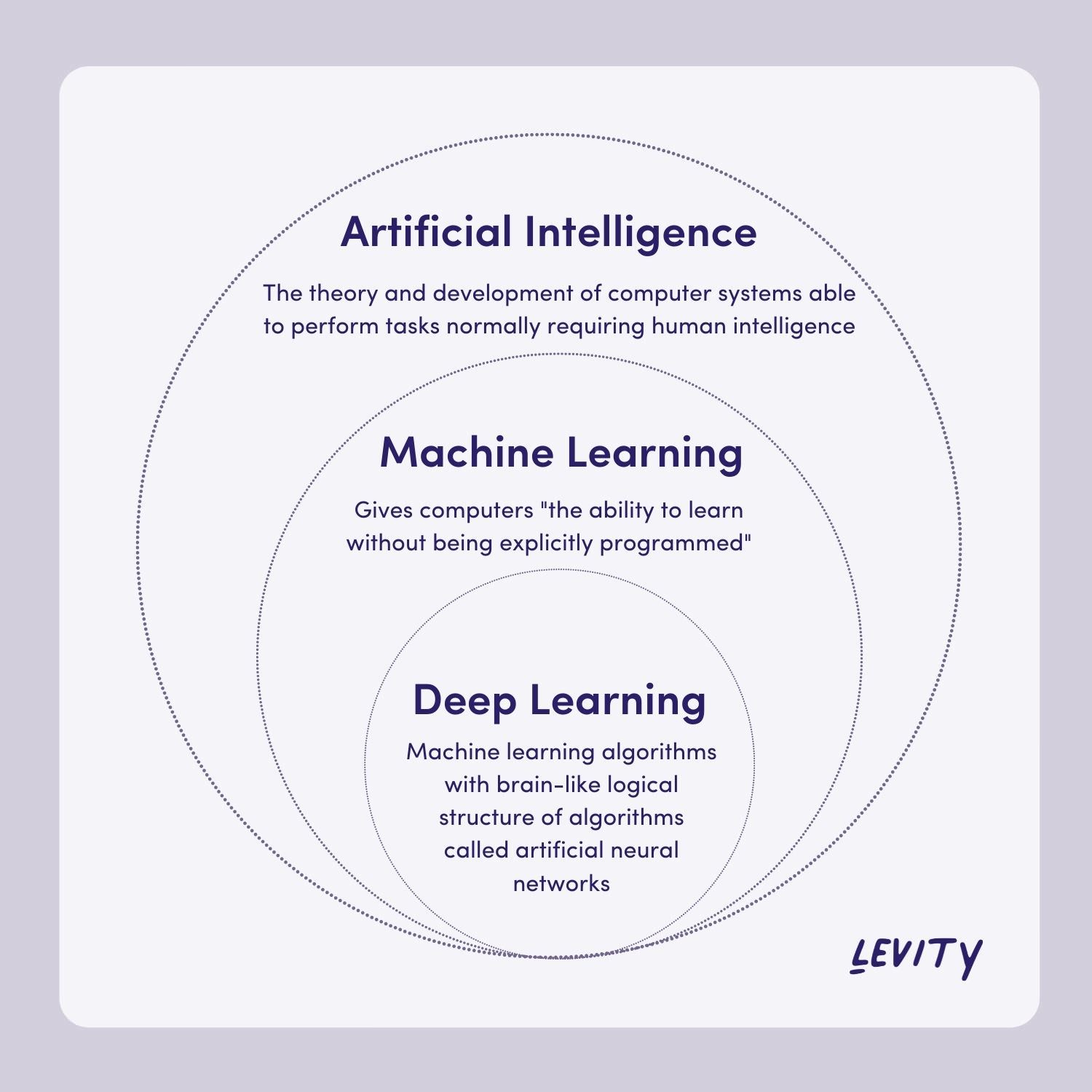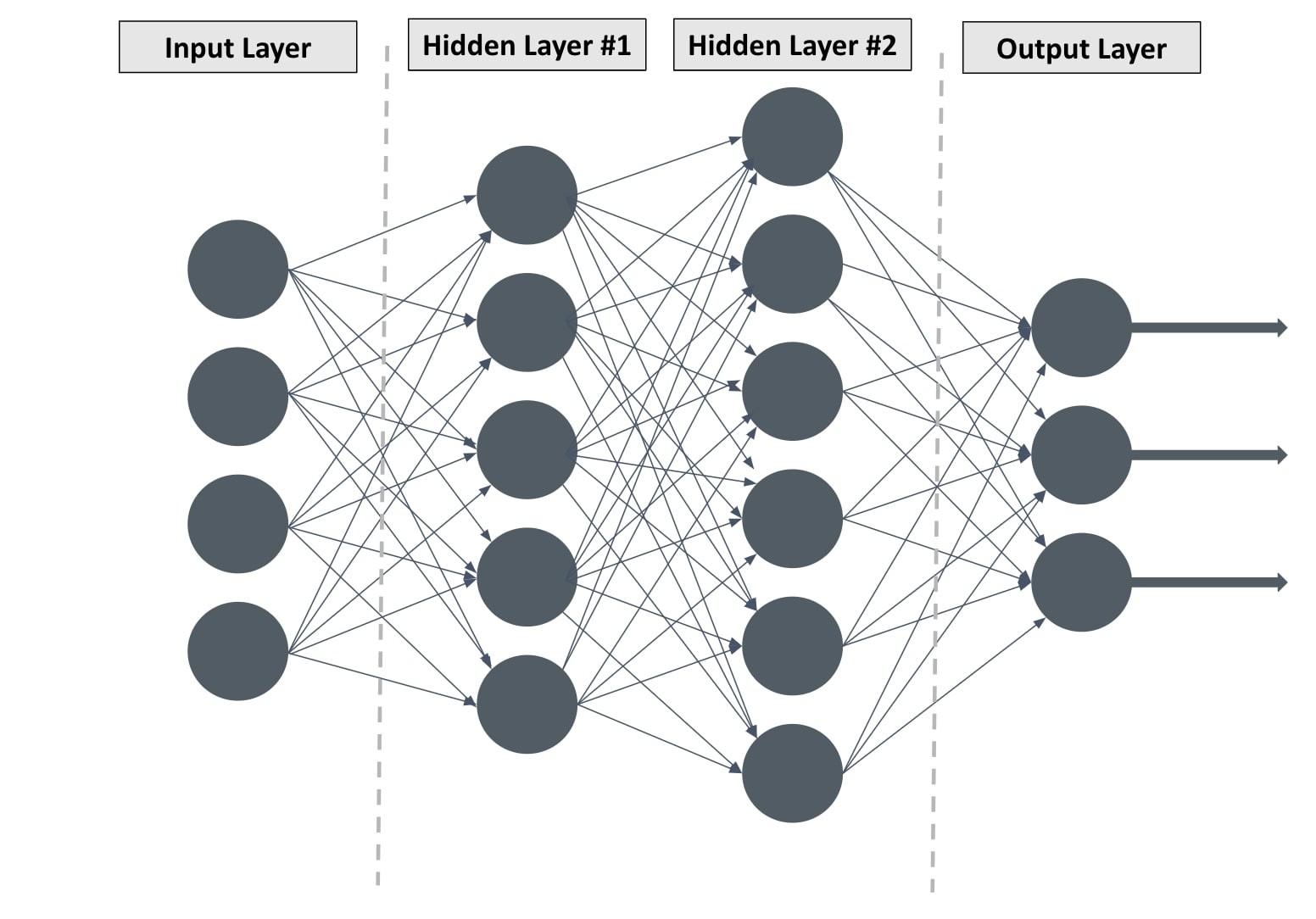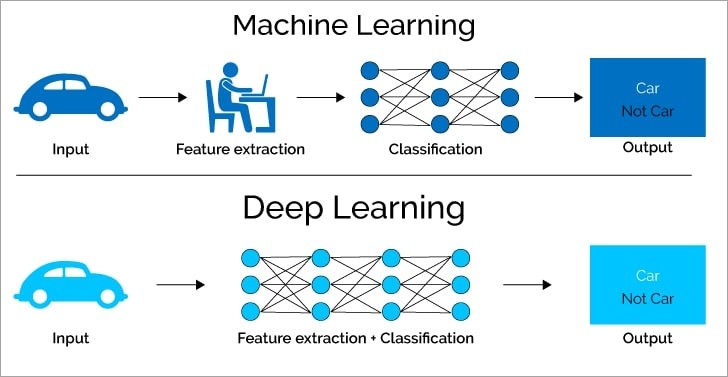Deep learning and machine learning are often used interchangeably, but they represent distinct approaches to artificial intelligence. At LEARNS.EDU.VN, we aim to clarify these concepts, providing you with a clear understanding of their differences and applications. Explore how these cutting-edge technologies transform data analysis, predictive modeling, and intelligent automation, unlocking a world of new possibilities. Understand the nuances between these powerful tools like neural networks, algorithms, and data analysis to empower your learning journey.
1. Understanding the Landscape: AI, Machine Learning, and Deep Learning
To effectively differentiate between deep learning and machine learning, it’s crucial to understand the broader context of artificial intelligence (AI). AI is the overarching concept of creating machines that can perform tasks that typically require human intelligence. Machine learning (ML) is a subset of AI that focuses on enabling systems to learn from data without explicit programming. Deep learning (DL) is a subfield of ML that uses artificial neural networks with multiple layers (hence “deep”) to analyze data in a way that mimics the human brain.
Alt text: Venn diagram illustrating the relationship between Artificial Intelligence, Machine Learning, and Deep Learning, with Deep Learning being a subset of Machine Learning, which in turn is a subset of AI.
In essence, deep learning is machine learning, but it employs more sophisticated techniques to achieve greater levels of accuracy and automation. Let’s delve deeper into each concept to highlight their key distinctions.
2. What is Machine Learning? A Comprehensive Overview
Machine learning empowers computers to learn from data through algorithms, enabling them to perform tasks without explicit programming. This interdisciplinary field combines computer science and statistics, allowing algorithms to identify patterns in data and make predictions when presented with new information. Traditional ML algorithms are designed to learn from data, improve accuracy, and automate decision-making processes.
Machine learning algorithms can be categorized into supervised and unsupervised learning, depending on the data used for training.
- Supervised Learning: Involves training algorithms on labeled datasets, where the desired output is known. This allows the algorithm to learn the relationship between input features and output labels.
- Unsupervised Learning: Involves training algorithms on unlabeled datasets, where the algorithm must discover patterns and structures on its own.
A simple example of a traditional machine-learning algorithm is linear regression. Imagine you want to predict a house’s price based on its size in square feet. You start by defining a function: price = y + x * square footage. Then, you provide the algorithm with training data consisting of the square footage and corresponding prices of several houses. The algorithm then draws a line through the data points using a method like ordinary least squares (OLS) regression. Now, you can give the algorithm the square footage of a new house, and it will predict its price.
Key characteristics of machine learning include:
- Learning from Data: ML algorithms learn patterns and relationships from data.
- Supervised and Unsupervised Learning: ML algorithms can be trained on labeled or unlabeled datasets.
- Simple Algorithms: Traditional ML algorithms can be as simple as linear regression.
3. Deep Learning Explained: Unveiling the Power of Neural Networks
Deep learning is an advanced form of machine learning that utilizes artificial neural networks (ANNs) with multiple layers to analyze data in a way that mimics the human brain. These algorithms can process unstructured data such as images, text, and audio, making them suitable for complex tasks like image recognition, natural language processing, and speech recognition. The layered structure of ANNs enables deep-learning models to learn intricate patterns and representations from vast amounts of data.
Alt text: Diagram of a simple artificial neural network showing the input layer, hidden layers, and output layer, illustrating how data flows through the network.
Consider an ANN with an input layer, an output layer, and multiple hidden layers in between. The hidden layers perform complex calculations to extract features and patterns from the input data. The more hidden layers a network has, the “deeper” it is. Any ANN with two or more hidden layers is considered a deep neural network.
Deep learning is widely used in various applications, including:
- Automated Driving: Detecting objects like traffic lights and pedestrians.
- Military Applications: Identifying objects from satellite imagery.
- Consumer Electronics: Powering home assistance devices like Amazon Alexa.
For example, Tesla uses deep learning algorithms to enable its cars to recognize STOP signs. The ANN identifies relevant features of the STOP sign, such as points, edges, and shapes. Unlike traditional machine learning algorithms, which require manual feature selection, ANNs can automatically perform feature engineering. The first hidden layer might learn how to detect edges, the next layer might learn how to differentiate colors, and the last layer might learn how to detect more complex shapes specific to the STOP sign.
Key characteristics of deep learning include:
- Artificial Neural Networks: Uses layered structures of algorithms called artificial neural networks.
- Automatic Feature Engineering: Automatically extracts relevant features from data.
- High Data Requirements: Requires vast amounts of data for training.
4. Key Differences: Machine Learning vs. Deep Learning
While deep learning is a subset of machine learning, several key differences distinguish the two approaches. These differences relate to algorithm structure, human intervention, data requirements, and computational resources.
| Feature | Machine Learning | Deep Learning |
|---|---|---|
| Algorithm Structure | Simpler algorithms like linear regression | Complex artificial neural networks with many layers |
| Human Intervention | Requires manual feature selection | Automatic feature engineering |
| Data Requirements | Works well with smaller datasets | Requires vast amounts of data |
| Computational Power | Lower computational requirements | Higher computational requirements |
| Problem Solving | Well-suited for simpler, well-defined problems | Excels at complex, unstructured problems |



To further illustrate these differences, consider the following points:
- Algorithm Structure: Machine learning algorithms typically have simpler structures, such as linear regression or decision trees. Deep learning, on the other hand, is based on artificial neural networks, which are complex and intertwined.
- Human Intervention: Machine learning often requires human intervention to manually select relevant features and adjust the algorithm. Deep learning algorithms can automatically extract features and learn from their own errors, reducing the need for human intervention.
- Data Requirements: Machine learning algorithms can work effectively with smaller datasets, often requiring just a few thousand data points. Deep learning algorithms, due to their complex structure, require millions of data points to eliminate fluctuations and make high-quality interpretations.
Alt text: Illustration comparing machine learning and deep learning, highlighting that deep learning algorithms perform automatic feature engineering.
5. The Rise of Transfer Learning: Bridging the Data Gap
One of the most significant advancements in deep learning is the emergence of transfer learning. Transfer learning involves using pre-trained models on new tasks, reducing the need for vast amounts of data and computational resources. These pre-trained models have been trained on large datasets and can be fine-tuned for specific applications, making deep learning more accessible and efficient.
Benefits of transfer learning include:
- Reduced Data Requirements: Transfer learning reduces the need for large training datasets.
- Faster Training Times: Pre-trained models can be fine-tuned more quickly than training a model from scratch.
- Improved Performance: Transfer learning can improve the performance of deep learning models, especially when data is limited.
6. Applications Across Industries: Real-World Examples
Both machine learning and deep learning have found applications across various industries, transforming the way businesses operate and make decisions. Here are some real-world examples:
- Healthcare: Machine learning is used for disease diagnosis, drug discovery, and personalized medicine. Deep learning is used for medical image analysis, identifying anomalies and patterns in medical scans.
- Finance: Machine learning is used for fraud detection, risk assessment, and algorithmic trading. Deep learning is used for sentiment analysis, predicting market trends based on news articles and social media data.
- Retail: Machine learning is used for recommendation systems, predicting customer preferences and providing personalized product recommendations. Deep learning is used for image recognition, identifying products in images and videos.
- Manufacturing: Machine learning is used for predictive maintenance, predicting equipment failures and optimizing maintenance schedules. Deep learning is used for quality control, detecting defects in products using computer vision.
7. Ethical Considerations: Addressing Bias and Fairness
As machine learning and deep learning become more prevalent, it’s essential to address ethical considerations such as bias and fairness. Biased data can lead to discriminatory outcomes, perpetuating inequalities and harming marginalized groups. It’s crucial to carefully evaluate the data used to train machine learning and deep learning models, ensuring that it is representative and free from bias.
Strategies for addressing bias and fairness include:
- Data Auditing: Auditing data for bias and imbalances.
- Algorithmic Fairness Metrics: Using metrics to measure and mitigate algorithmic bias.
- Transparency and Explainability: Promoting transparency and explainability in machine learning models.
8. The Future of AI: Trends and Innovations
The field of artificial intelligence is constantly evolving, with new trends and innovations emerging at a rapid pace. Some of the key trends shaping the future of AI include:
- Explainable AI (XAI): Focuses on making AI models more transparent and interpretable.
- Federated Learning: Enables machine learning models to be trained on decentralized data sources without sharing the data.
- Generative AI: Involves creating models that can generate new content, such as images, text, and music.
- Reinforcement Learning: Involves training agents to make decisions in an environment to maximize a reward.
Staying abreast of these trends and innovations is essential for leveraging the full potential of AI and driving innovation across industries.
9. LEARNS.EDU.VN: Your Gateway to AI Education
At LEARNS.EDU.VN, we are committed to providing high-quality educational resources to help you master the concepts of machine learning and deep learning. Our comprehensive courses, tutorials, and articles cover a wide range of topics, from the fundamentals of machine learning to advanced deep learning techniques. Whether you’re a beginner or an experienced professional, LEARNS.EDU.VN has something to offer.
We understand the challenges faced by learners, such as:
- Finding reliable and high-quality learning materials.
- Maintaining motivation and focus during the learning process.
- Understanding complex concepts and algorithms.
- Knowing where to start when learning a new skill.
To address these challenges, we offer services that:
- Provide detailed and easy-to-understand tutorials on various topics.
- Share proven methods for effective learning and skill development.
- Explain complex concepts in a simple and intuitive way.
- Offer clear learning paths for different fields.
- Recommend useful learning resources and tools.
- Connect learners with educational experts.
10. Taking the Next Step: Practical Learning Resources at LEARNS.EDU.VN
Ready to dive deeper into the world of machine learning and deep learning? LEARNS.EDU.VN offers a range of resources to help you get started:
- Courses: Enroll in our comprehensive courses on machine learning, deep learning, and artificial intelligence.
- Tutorials: Follow our step-by-step tutorials to learn specific techniques and algorithms.
- Articles: Explore our in-depth articles on various AI-related topics.
- Community: Join our community to connect with other learners and experts.
Here’s a glimpse of what you can expect to find on LEARNS.EDU.VN:
- Detailed Guides: Step-by-step instructions with clear explanations.
- Proven Methods: Effective learning techniques backed by research.
- Simplified Concepts: Easy-to-understand explanations of complex ideas.
- Clear Pathways: Structured learning paths for different areas of interest.
- Useful Resources: Recommendations for the best learning tools and materials.
- Expert Connections: Opportunities to connect with educational professionals.
Visit LEARNS.EDU.VN today to explore our resources and start your AI learning journey.
Frequently Asked Questions (FAQ)
1. What is the main difference between machine learning and deep learning?
The main difference lies in the algorithm structure and data requirements. Machine learning uses simpler algorithms and can work with smaller datasets, while deep learning uses complex artificial neural networks and requires vast amounts of data.
2. Is deep learning always better than machine learning?
No, deep learning is not always better. It depends on the problem and the amount of available data. For simpler problems with limited data, traditional machine learning algorithms may be more effective.
3. What are the applications of deep learning?
Deep learning is used in various applications, including automated driving, medical image analysis, natural language processing, and speech recognition.
4. What is transfer learning, and why is it important?
Transfer learning involves using pre-trained models on new tasks, reducing the need for vast amounts of data and computational resources. It makes deep learning more accessible and efficient.
5. How can I get started with machine learning and deep learning?
You can start by enrolling in online courses, following tutorials, and exploring articles on machine learning and deep learning. Platforms like LEARNS.EDU.VN offer comprehensive resources to help you get started.
6. What are the ethical considerations in machine learning and deep learning?
Ethical considerations include addressing bias and fairness in data and algorithms to ensure that machine learning and deep learning models do not perpetuate inequalities.
7. What is Explainable AI (XAI)?
Explainable AI (XAI) focuses on making AI models more transparent and interpretable, allowing users to understand how the models make decisions.
8. What is federated learning?
Federated learning enables machine learning models to be trained on decentralized data sources without sharing the data, preserving privacy and security.
9. What are some emerging trends in AI?
Emerging trends in AI include generative AI, reinforcement learning, and federated learning.
10. How can LEARNS.EDU.VN help me learn machine learning and deep learning?
LEARNS.EDU.VN offers comprehensive courses, tutorials, and articles on machine learning and deep learning, providing you with the resources you need to master these concepts.
Conclusion: Embracing the Future with LEARNS.EDU.VN
The distinction between deep learning and machine learning is crucial for understanding the capabilities and applications of artificial intelligence. While machine learning provides a broad foundation for learning from data, deep learning offers advanced techniques for solving complex problems. By understanding the nuances of each approach, you can leverage the power of AI to drive innovation and create value in various industries.
Visit LEARNS.EDU.VN at 123 Education Way, Learnville, CA 90210, United States or contact us via Whatsapp at +1 555-555-1212. Let LEARNS.EDU.VN be your guide to mastering machine learning and deep learning, empowering you to unlock the full potential of artificial intelligence. Embrace the future of learning with learns.edu.vn.